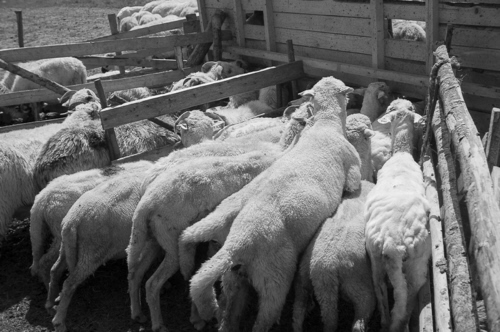The Catean family lives in the lowlands in the village of Rotbav about 20 km north of Brasov. There, they have a dairy where they produce cheese twice daily, while their horses live in a stable a few kilometres northwards, and their sheep stay on meadows a short drive from the farm. Early in the morning we could watch cheese being made more or less manually, first by pouring milk from a milk can through a filter into a large container, then heating the milk to about 40°C and adding rennet to separate the cheese mass from the liquid. After waiting about half an hour, it was time for separation where the cheese mass was lifted by hand into a wide, open container with an opening in one end and being oblique such that the liquid could flow out and being collected in another container. Putting the remaining cheese mass in a porous cloth, and compressing it in various ways, even more liquid was ejected. Finally, the dairy workers tied the cloth tightly around the cheese mass and put wooden boards and weights on the top in order to get rid of even more liquid.
The three sons of the Catean family, Silviu, George and Ionut, have taken university degrees, but all of them prefer to stay at their parents’ farm. One of them told my guide that it is in their blood to be farmers, and they can’t help it. However, they are running a profitable farm and their products are renowned for their excellent quality.
All the brothers are members of Slow Food Brasov, and they have been actively participating in a project called Transhumance 2013 where 6 shepherds and a flock of sheep too young to produce milk walked along the whole of the Carpathians from Romania to Poland, via Ukraine, the Czech republic, Slovakia and Poland, a distance of about 1400 km. Actually, transhumance is as old as the hills, often being practised by farmers living in the lowlands bringing their livestock to the highlands in spring and back again in autumn. Besides, nomads have gone wherever there was food for their animals for millennia. However, due to border controls, passports, etc. this has more or less stopped, and it is to be hoped that their project will be an annual event.
After having paid a visit to their beautiful horses residing indoors due to the strong heat, we went by horse and cart to their sheepfold. Walking on a gravel road, the horse brought us to a sheepfold, while her foal was walking next to her. There, they could both eat as much as they wanted, while we were visiting the sheepfold. It seems like Romanian sheepfolds are organised in more or less the same way, with an outer fence and an inner one located next to a shed where the shepherds are milking the sheep. The sheep enter through two openings in the shed, before getting milked by one of four shepherds. It was unbearably hot with no shade, but the sheep were waiting patiently, and the horse was sweating heavily. How man and animals survive, I have no idea, but probably the horses and the sheep best suited to the heat have been selected for breeding since ancient times. Going back again in a horse-drawn cart, we passed a nest of storks, 3 chickens and one adult. How they survive the heat is another mystery.

